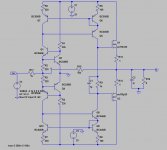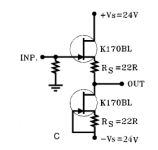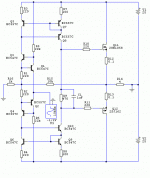Hi all.
I was in the mood for modifying an old amp i made ~10 years ago.
Change R9 to set idle current - 500R -> 0.5amp.
It does not need any compensation.
It is stable into capacitive load.
The openloop gain is not that high, but the harmonics fall nicely of.
CLG is 20dB
OLG is 82dB
And the amp will be able to compete with an gainclone amp regarding size.
Bandwidth is >350KHz.
I was in the mood for modifying an old amp i made ~10 years ago.
Change R9 to set idle current - 500R -> 0.5amp.
It does not need any compensation.
It is stable into capacitive load.
The openloop gain is not that high, but the harmonics fall nicely of.
CLG is 20dB
OLG is 82dB
And the amp will be able to compete with an gainclone amp regarding size.
Bandwidth is >350KHz.
Attachments
Last edited:
You can drive it from a jfet buffer like in this paper:
http://www.tkhifi.com/div/Erno_Borbely_fet_articel_2.pdf
Or you can choose a good cheap opamp like: LME49721M to drive. Both types have no problem with the 1K Zin.
http://www.tkhifi.com/div/Erno_Borbely_fet_articel_2.pdf
Or you can choose a good cheap opamp like: LME49721M to drive. Both types have no problem with the 1K Zin.
Yes precisely. And use the DAC's internal volume control.
The feedback network the needs to be changed. But basicly the Resistor R11 should be shorted and R10 need to be changed to match the output to 0dB from the DAC currentsource.
The feedback network the needs to be changed. But basicly the Resistor R11 should be shorted and R10 need to be changed to match the output to 0dB from the DAC currentsource.
You can drive it from a jfet buffer like in this paper:
http://www.tkhifi.com/div/Erno_Borbely_fet_articel_2.pdf
Or you can choose a good cheap opamp like: LME49721M to drive. Both types have no problem with the 1K Zin.
I wouldn't drive it from complemetary JFET buffer - it sounds inferior to SE and SE can't drive it.
And if we choose an OpAmp as buffer we might as well use the LM3886 or OPA549 as amp.
So, stop offering bad solutions and change the amp so that Zin=10k or more (without added complexity) 😀
I wouldn't drive it from complemetary JFET buffer - it sounds inferior to SE and SE can't drive it.
And if we choose an OpAmp as buffer we might as well use the LM3886 or OPA549 as amp.
So, stop offering bad solutions and change the amp so that Zin=10k or more (without added complexity) 😀
What do you mean when saying "stop offering bad solution"??
Another possibility would be a fairly high biased output compound à la Hiraga and resistor loaded input. A great topology.
SonnyaYou can drive it from a jfet buffer like in this paper:
http://www.tkhifi.com/div/Erno_Borbely_fet_articel_2.pdf
You have a nice amplifier there.
For input I think a two-NJFET solution
like the Borbely fetbuffer here is good:
.
Attachments
Hi WuYit.
Juma wanted a higher input impedance. And i suggested a buffer like the One Lineup pointed at.
You can get a high input impedance, but it will be on the cost of speed and offset.
The speed is mainly because it is a CFB design where in+ is grounded.
This amp sounded good, but did lack performance into difficult load as it used BJT outputs which loaded the VAS stage heavier as load was more lowimpedant.
- know the "Le monstre" It's a good and simple design. But it is only 8W and this one is a ~25W. Maybe it will end up as a Naim nait sized amp....
- Sonny
Juma wanted a higher input impedance. And i suggested a buffer like the One Lineup pointed at.
You can get a high input impedance, but it will be on the cost of speed and offset.
The speed is mainly because it is a CFB design where in+ is grounded.
This amp sounded good, but did lack performance into difficult load as it used BJT outputs which loaded the VAS stage heavier as load was more lowimpedant.
- know the "Le monstre" It's a good and simple design. But it is only 8W and this one is a ~25W. Maybe it will end up as a Naim nait sized amp....
- Sonny
... Juma wanted a higher input impedance. ...
Sorry Sonny, there was a misunderstanding - I don't want anything. When I want something, I make it myself.
I just noticed that potentially fine amp could be sonically degraded by use of inappropriate buffers. I built and tested more than my share of amps and buffers (including those listed in Borbely's articles) and it's my opinion that slight change in your amp's topology (to achieve higher Zin) would be very beneficial. But it's your amp...
Keep up the good work

If the input signal is a current then your topology is OK, if it is a voltage then the input stage should be changed. That´s the point.
- Status
- Not open for further replies.
- Home
- Amplifiers
- Solid State
- Yet another amp - simple inverted with 10x gain, mosfet output stage


